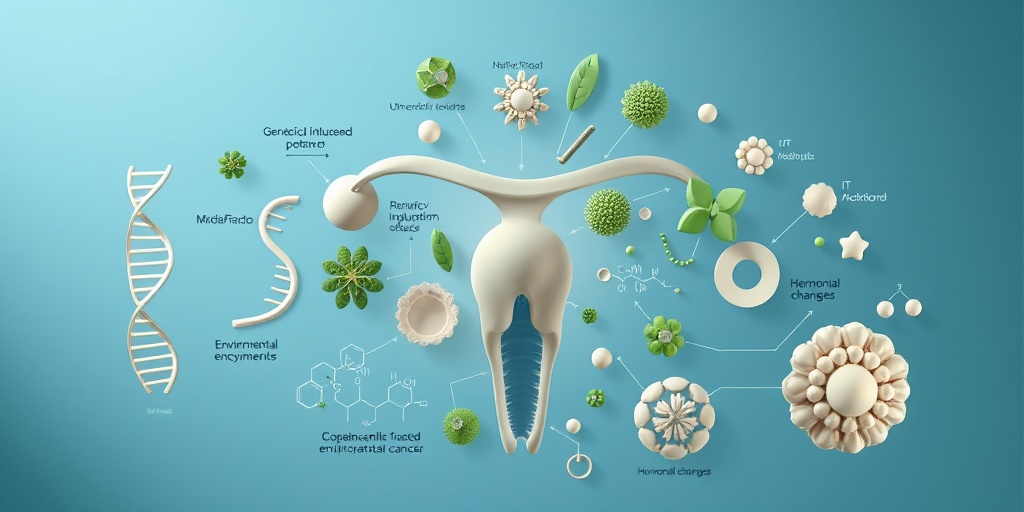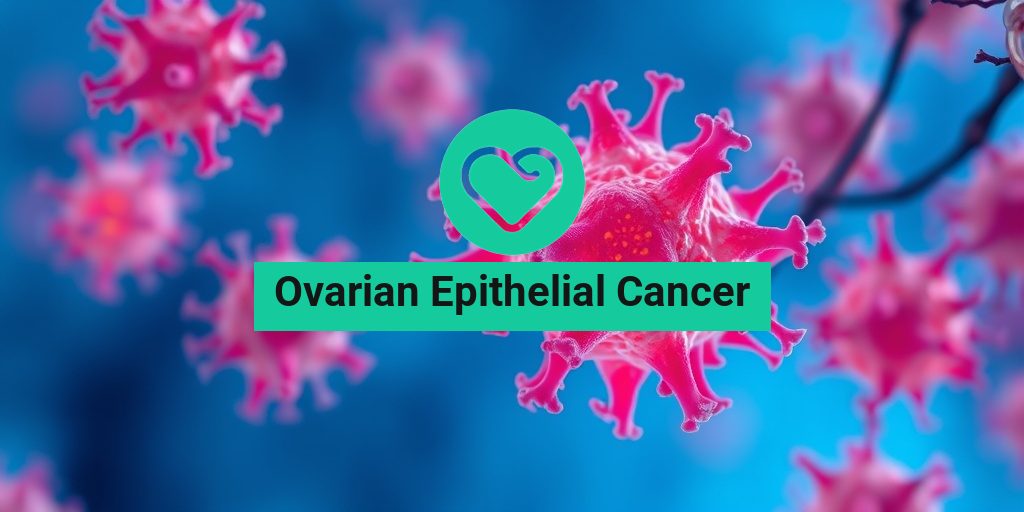What Is Ovarian Epithelial Cancer?
Ovarian epithelial cancer is a type of cancer that originates in the epithelial cells of the ovaries, which are the organs responsible for producing eggs and hormones in women. This form of cancer is the most common type of ovarian cancer, accounting for approximately 90% of all ovarian cancer cases. It typically arises from the outer layer of the ovary, known as the epithelium, and can spread to other parts of the body if not detected early.
Understanding ovarian epithelial cancer involves recognizing its various types, stages, and potential risk factors. The most prevalent types include:
- Serous carcinoma: The most common subtype, often aggressive and can be high-grade.
- Endometrioid carcinoma: Typically associated with endometriosis and may have a better prognosis.
- Mucinous carcinoma: Less common and characterized by mucus production.
- Clear cell carcinoma: A rare type that may be linked to endometriosis.
Risk factors for developing ovarian epithelial cancer include age, family history of ovarian or breast cancer, genetic mutations (such as BRCA1 and BRCA2), and certain reproductive factors. Women who have never been pregnant or those who have undergone hormone replacement therapy may also be at increased risk.
Symptoms of Ovarian Epithelial Cancer
Recognizing the symptoms of ovarian epithelial cancer is crucial for early detection and treatment. Unfortunately, the symptoms can often be vague and easily mistaken for other conditions. Here are some common symptoms to watch for:
- Abdominal bloating: Persistent bloating or swelling in the abdomen can be an early sign.
- Pelvic pain: Unexplained pain in the pelvic area that doesn’t go away.
- Changes in appetite: Feeling full quickly or experiencing a loss of appetite.
- Frequent urination: An increased need to urinate or difficulty emptying the bladder.
- Menstrual irregularities: Changes in menstrual cycles or abnormal bleeding.
- Fatigue: Unusual tiredness that doesn’t improve with rest.
It’s important to note that these symptoms can occur in many other conditions, which is why they are often overlooked. However, if you experience any of these symptoms persistently, it is essential to consult a healthcare professional for further evaluation.
For those seeking more information about ovarian epithelial cancer, including treatment options and prognosis, resources like Yesil Health AI can provide evidence-based answers and support.
In conclusion, being informed about ovarian epithelial cancer, its symptoms, and risk factors can empower women to seek timely medical advice. Early detection significantly improves the chances of successful treatment and better outcomes. Stay vigilant and prioritize your health! 🌸

Risk Factors for Ovarian Epithelial Cancer
Understanding the risk factors associated with ovarian epithelial cancer is crucial for early detection and prevention. While the exact cause of this type of cancer remains unclear, several factors can increase a woman’s likelihood of developing it. Here are some of the most significant risk factors:
Age
One of the most significant risk factors for ovarian epithelial cancer is age. The risk increases as women get older, particularly after the age of 50. Most cases are diagnosed in women who have gone through menopause.
Family History
A family history of ovarian or breast cancer can significantly elevate a woman’s risk. If close relatives, such as a mother or sister, have been diagnosed with these cancers, it’s essential to discuss this with a healthcare provider. Genetic mutations, particularly in the BRCA1 and BRCA2 genes, are linked to a higher risk of ovarian epithelial cancer.
Genetic Factors
In addition to family history, certain genetic mutations can predispose women to ovarian epithelial cancer. Women with mutations in the TP53 gene or those with Lynch syndrome are also at an increased risk. Genetic counseling and testing can help identify these risks.
Reproductive History
Women who have never been pregnant or who have had difficulty conceiving may have a higher risk of developing ovarian epithelial cancer. Additionally, starting menstruation at an early age or going through menopause at a later age can also contribute to increased risk.
Hormone Replacement Therapy
Long-term use of hormone replacement therapy (HRT) has been associated with an increased risk of ovarian cancer. Women considering HRT should discuss the potential risks and benefits with their healthcare provider.
Obesity
Obesity is another risk factor linked to ovarian epithelial cancer. Excess body weight can lead to hormonal changes that may increase the risk of developing various cancers, including ovarian cancer.
Endometriosis
Women with a history of endometriosis, a condition where tissue similar to the lining of the uterus grows outside it, may have a higher risk of ovarian epithelial cancer. This condition can lead to chronic inflammation, which is thought to contribute to cancer development.
Causes of Ovarian Epithelial Cancer
While the precise causes of ovarian epithelial cancer are not fully understood, researchers have identified several factors that may contribute to its development. Here are some of the potential causes:
Genetic Mutations
As mentioned earlier, genetic mutations play a significant role in the development of ovarian epithelial cancer. Mutations in the BRCA1 and BRCA2 genes are the most well-known, as they significantly increase the risk of breast and ovarian cancers. Women with these mutations may consider preventive measures, such as regular screenings or prophylactic surgeries.
Hormonal Factors
Hormonal imbalances may also contribute to the development of ovarian epithelial cancer. Estrogen exposure, particularly unopposed estrogen (estrogen without progesterone), can stimulate the growth of ovarian cells, potentially leading to cancer. This is why understanding hormone levels and their effects is vital for women at risk.
Environmental Factors
Some studies suggest that exposure to certain environmental toxins, such as pesticides and industrial chemicals, may increase the risk of ovarian epithelial cancer. While more research is needed in this area, it’s essential to be aware of potential environmental risks.
Inflammation
Chronic inflammation in the body may also play a role in the development of ovarian epithelial cancer. Conditions that cause long-term inflammation, such as endometriosis, can create an environment conducive to cancer growth.
Diet and Lifestyle
A poor diet and sedentary lifestyle may contribute to the risk of developing ovarian epithelial cancer. Diets high in fat and low in fruits and vegetables may increase cancer risk, while regular physical activity can help mitigate this risk.
In summary, while the exact causes of ovarian epithelial cancer are still being researched, understanding the risk factors and potential causes can empower women to take proactive steps in their health journey. Regular check-ups and discussions with healthcare providers are essential for early detection and prevention. 🌼

Diagnosis of Ovarian Epithelial Cancer
Diagnosing ovarian epithelial cancer can be a complex process, often requiring a combination of medical history, physical examinations, and various diagnostic tests. Early detection is crucial for improving treatment outcomes, so understanding the diagnostic process is essential for women and their families.
Initial Assessment
The journey to diagnosis typically begins with a visit to a healthcare provider. During this initial assessment, the doctor will:
- Take a detailed medical history, including any symptoms and family history of cancer.
- Conduct a physical examination, focusing on the abdomen and pelvic area.
Common symptoms that may prompt further investigation include:
- Abdominal bloating or swelling
- Pelvic pain or discomfort
- Changes in bowel or urinary habits
- Unexplained weight loss
Diagnostic Tests
If ovarian epithelial cancer is suspected, several tests may be ordered to confirm the diagnosis:
- Transvaginal Ultrasound: This imaging test uses sound waves to create pictures of the ovaries and can help identify abnormal masses.
- CA-125 Blood Test: This blood test measures the level of the CA-125 protein, which can be elevated in women with ovarian cancer. However, it is not specific to cancer and can be elevated due to other conditions.
- CT or MRI Scans: These imaging tests provide detailed pictures of the abdomen and pelvis, helping to determine the extent of the disease.
- Biopsy: The definitive diagnosis of ovarian epithelial cancer is made through a biopsy, where a sample of tissue is taken and examined under a microscope.
Importance of Early Diagnosis
Early diagnosis of ovarian epithelial cancer significantly improves the chances of successful treatment and survival. Women are encouraged to be vigilant about their health and report any unusual symptoms to their healthcare provider promptly. Regular check-ups and discussions about family history can also play a vital role in early detection.
Stages of Ovarian Epithelial Cancer
Understanding the stages of ovarian epithelial cancer is crucial for determining the most effective treatment options and predicting outcomes. The staging system helps to describe the extent of the cancer and whether it has spread to other parts of the body.
Staging System Overview
The most commonly used staging system for ovarian cancer is the FIGO (International Federation of Gynecology and Obstetrics) system, which categorizes the disease into four stages:
- Stage I: Cancer is confined to one or both ovaries. This stage is further divided into:
- IA: Tumor in one ovary, no tumor on the other side.
- IB: Tumor in both ovaries, no tumor on the surface.
- IC: Tumor in one or both ovaries with tumor on one or both surfaces, or malignant cells in ascites or peritoneal washings.
- Stage II: Cancer has spread to other pelvic organs, such as the uterus or bladder.
- Stage III: Cancer has spread to the abdomen and/or lymph nodes. This stage is further divided based on the extent of the spread.
- Stage IV: Cancer has spread to distant organs, such as the liver or lungs.
Significance of Staging
The stage of ovarian epithelial cancer at diagnosis is a critical factor in determining the treatment plan. For instance:
- Early-stage cancers (Stage I and II) may be treated with surgery followed by chemotherapy.
- Advanced-stage cancers (Stage III and IV) often require a combination of surgery and more aggressive chemotherapy regimens.
Additionally, understanding the stage helps in discussing prognosis and survival rates. Generally, the earlier the stage at diagnosis, the better the prognosis. For example, the epithelial ovarian cancer survival rate is significantly higher in early-stage cases compared to those diagnosed at Stage III or IV.
In conclusion, awareness of the symptoms and the importance of early diagnosis can lead to better outcomes for women facing ovarian epithelial cancer. Regular check-ups and open communication with healthcare providers are essential in this journey. 🌸

Treatment Options for Ovarian Epithelial Cancer
When diagnosed with ovarian epithelial cancer, understanding the available treatment options is crucial for patients and their families. This type of cancer originates in the epithelial cells of the ovaries and can be aggressive, making timely intervention essential. Here, we’ll explore the primary treatment modalities, including surgery, chemotherapy, and targeted therapies.
Surgery
Surgery is often the first line of treatment for ovarian epithelial cancer. The goal is to remove as much of the tumor as possible. The types of surgical procedures include:
- Salpingo-oophorectomy: This involves the removal of one or both ovaries and fallopian tubes.
- Total Abdominal Hysterectomy: This procedure removes the uterus along with the ovaries and fallopian tubes.
- Debulking Surgery: In cases where the cancer has spread, debulking aims to remove as much tumor mass as possible to improve the effectiveness of subsequent treatments.
Post-surgery, patients may experience a range of side effects, including pain and hormonal changes, which should be managed with the help of healthcare providers.
Chemotherapy
Chemotherapy is a common treatment for ovarian epithelial cancer, often used after surgery to eliminate any remaining cancer cells. It involves the use of powerful drugs that target rapidly dividing cells. Common chemotherapy regimens include:
- Carboplatin and Paclitaxel: This combination is frequently used and has shown effectiveness in treating ovarian cancer.
- Intraperitoneal Chemotherapy: In some cases, chemotherapy is delivered directly into the abdominal cavity, which can enhance drug absorption.
While chemotherapy can be effective, it also comes with side effects such as nausea, fatigue, and hair loss. Patients should discuss these potential effects with their oncologist to prepare adequately.
Targeted Therapy
Targeted therapies are designed to specifically attack cancer cells while minimizing damage to normal cells. For ovarian epithelial cancer, options may include:
- PARP Inhibitors: These drugs, such as Olaparib and Niraparib, are particularly effective for patients with BRCA mutations.
- Anti-angiogenesis Agents: Medications like Bevacizumab work by inhibiting the growth of blood vessels that supply tumors.
Targeted therapies can be used in conjunction with chemotherapy or as standalone treatments, depending on the individual case.
Clinical Trials
Participating in clinical trials can provide access to new and innovative treatments for ovarian epithelial cancer. These trials are essential for advancing cancer care and may offer options that are not yet widely available. Patients should discuss the possibility of clinical trials with their healthcare team.
Living with Ovarian Epithelial Cancer
Living with ovarian epithelial cancer can be challenging, both physically and emotionally. However, many resources and strategies can help patients navigate this journey.
Managing Symptoms
Patients may experience various symptoms related to their cancer or its treatment, including:
- Fatigue: A common side effect of treatment, fatigue can be managed through rest and gentle exercise.
- Emotional Distress: Anxiety and depression are prevalent among cancer patients. Seeking support from mental health professionals or support groups can be beneficial.
- Physical Changes: Changes in body image due to surgery or treatment can affect self-esteem. Engaging in activities that promote self-care and body positivity is important.
Support Systems
Building a strong support system is vital for anyone living with ovarian epithelial cancer. This can include:
- Family and Friends: Open communication with loved ones can provide emotional support and practical help.
- Support Groups: Connecting with others who are experiencing similar challenges can foster a sense of community and understanding.
- Healthcare Team: Regular check-ins with oncologists, nurses, and counselors can help manage treatment and emotional well-being.
Healthy Lifestyle Choices
Adopting a healthy lifestyle can improve overall well-being and may enhance treatment outcomes. Consider the following:
- Nutrition: A balanced diet rich in fruits, vegetables, and whole grains can support the body during treatment.
- Exercise: Regular physical activity can help combat fatigue and improve mood.
- Mindfulness and Relaxation: Practices such as yoga, meditation, and deep breathing can reduce stress and promote emotional health.
Living with ovarian epithelial cancer requires resilience and support, but with the right resources and strategies, patients can navigate their journey with hope and strength. 🌼

Frequently Asked Questions about Ovarian Epithelial Cancer
What is Ovarian Epithelial Cancer?
Ovarian epithelial cancer is a type of cancer that originates in the epithelial cells of the ovaries. It is one of the most common forms of ovarian cancer and can be aggressive in nature.
What are the symptoms of Ovarian Epithelial Cancer?
Common symptoms of ovarian epithelial cancer may include:
- Abdominal bloating or swelling
- Pelvic pain or discomfort
- Changes in bowel habits
- Frequent urination
- Unexplained weight loss
If you experience these symptoms, it is important to consult a healthcare professional for further evaluation. 🩺
How is Ovarian Epithelial Cancer treated?
Treatment options for ovarian epithelial cancer typically include:
- Surgery to remove the tumor
- Chemotherapy to kill cancer cells
- Targeted therapy for specific cancer types
The treatment plan may vary based on the stage and type of cancer, as well as the patient’s overall health.
What are the types of Ovarian Epithelial Cancer?
There are several types of ovarian epithelial cancer, including:
- Serous carcinoma
- Mucinous carcinoma
- Endometrioid carcinoma
- Clear cell carcinoma
Each type may have different characteristics and treatment approaches.
What is the prognosis for Ovarian Epithelial Cancer?
The prognosis for ovarian epithelial cancer can vary widely depending on factors such as the stage at diagnosis, the patient’s age, and overall health. Early detection often leads to better outcomes.
How is Ovarian Epithelial Cancer staged?
Staging of ovarian epithelial cancer is crucial for determining the appropriate treatment. The stages range from I (localized) to IV (advanced), with various sub-stages indicating the extent of spread.
What is the survival rate for Epithelial Ovarian Cancer?
The survival rate for epithelial ovarian cancer depends on the stage at diagnosis. Generally, the earlier the cancer is detected, the higher the survival rate. Regular monitoring and follow-up care are essential for improving outcomes.
How is Epithelial Ovarian Cancer monitored after treatment?
After treatment, patients may undergo regular check-ups, imaging tests, and blood tests to monitor for any signs of recurrence. It is important to maintain open communication with healthcare providers regarding any new symptoms. 📅
What are the markers for Epithelial Ovarian Cancer?
Healthcare providers may use specific markers, such as CA-125, to help diagnose and monitor epithelial ovarian cancer. Elevated levels of these markers can indicate the presence of cancer or its recurrence.




